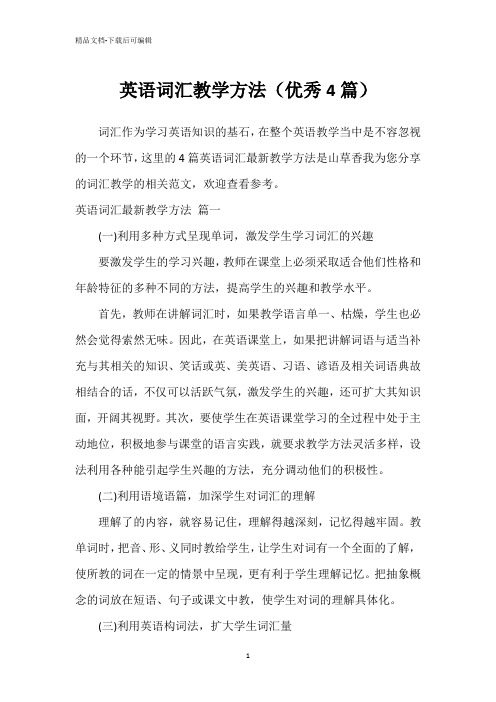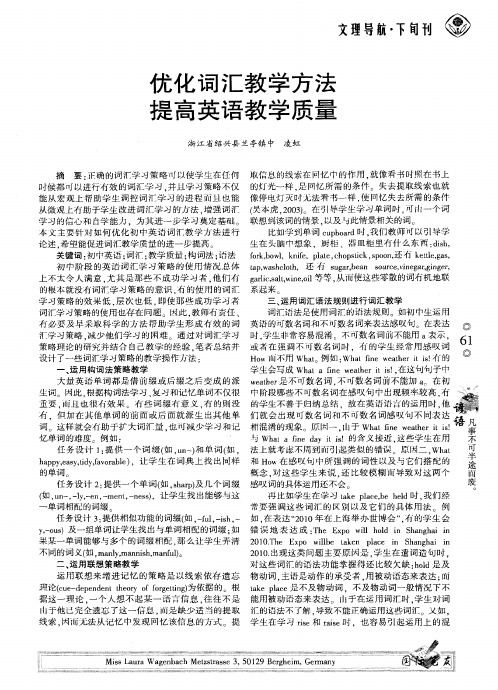运用词汇学知识,提高英语词汇教学效果
- 格式:doc
- 大小:16.00 KB
- 文档页数:4

英语词汇教学方法(优秀4篇)词汇作为学习英语知识的基石,在整个英语教学当中是不容忽视的一个环节,这里的4篇英语词汇最新教学方法是山草香我为您分享的词汇教学的相关范文,欢迎查看参考。
英语词汇最新教学方法篇一(一)利用多种方式呈现单词,激发学生学习词汇的兴趣要激发学生的学习兴趣,教师在课堂上必须采取适合他们性格和年龄特征的多种不同的方法,提高学生的兴趣和教学水平。
首先,教师在讲解词汇时,如果教学语言单一、枯燥,学生也必然会觉得索然无味。
因此,在英语课堂上,如果把讲解词语与适当补充与其相关的知识、笑话或英、美英语、习语、谚语及相关词语典故相结合的话,不仅可以活跃气氛,激发学生的兴趣,还可扩大其知识面,开阔其视野。
其次,要使学生在英语课堂学习的全过程中处于主动地位,积极地参与课堂的语言实践,就要求教学方法灵活多样,设法利用各种能引起学生兴趣的方法,充分调动他们的积极性。
(二)利用语境语篇,加深学生对词汇的理解理解了的内容,就容易记住,理解得越深刻,记忆得越牢固。
教单词时,把音、形、义同时教给学生,让学生对词有一个全面的了解,使所教的词在一定的情景中呈现,更有利于学生理解记忆。
把抽象概念的词放在短语、句子或课文中教,使学生对词的理解具体化。
(三)利用英语构词法,扩大学生词汇量英语词汇量虽然庞大,但它本身却有其内在规律可寻,掌握基本的构词方法,能很容易突破记忆单词的难关。
词根、前缀、后缀是构成单词的三个元素,他们是扩大词汇量的三把钥匙。
词缀法是派生法的一种,英语词缀分成前缓和后缀两种,加在词根前的叫前缀,加于词根后的叫后缀。
前缀一般只改变词的意义,但并不改变其词类。
把词缀同它前面的单词或词根联系起来考察,有助于记住单词的词类和词义。
后缀不仅改变词的意义,而且使单词由一种词类转变为另一种词类。
在教学中,教师日常帮助学生成让学生自己归纳总结,可以扩大他们的词汇量。
(四)有计划的复现单词,复习巩固所学词汇人的记忆时间有长有短,按照人的记忆规律,一般在一定时间内对新接触的事物名称通过三到五次反复就可以熟记在心。


课程目标:1. 帮助学生掌握大学英语词汇的基本概念和分类。
2. 提高学生词汇记忆能力,学会科学记忆方法。
3. 培养学生词汇运用能力,提高英语实际应用水平。
课时:2课时教学内容:1. 词汇学基本概念2. 词汇分类及学习方法3. 科学记忆方法4. 词汇运用练习教学过程:一、导入(5分钟)1. 老师简要介绍本节课的教学目标和内容。
2. 引导学生思考:如何提高词汇学习效果?二、词汇学基本概念(10分钟)1. 介绍词汇的定义、分类和作用。
2. 讲解词汇学的基本概念,如:词义、词性、构词法等。
三、词汇分类及学习方法(20分钟)1. 介绍词汇的分类:名词、动词、形容词、副词等。
2. 讲解词汇学习方法:a. 利用词根、词缀进行记忆;b. 通过语境记忆,学会联想记忆;c. 多读、多写、多听、多说,提高词汇运用能力。
四、科学记忆方法(15分钟)1. 介绍几种科学记忆方法:a. 星火式记忆法;b. 归纳法;c. 重复法;d. 语境记忆法。
2. 学生结合自身情况,选择适合自己的记忆方法。
五、词汇运用练习(20分钟)1. 老师给出几个与课程内容相关的词汇,让学生进行造句。
2. 学生互相检查、评价,老师点评。
六、总结与反馈(5分钟)1. 老师对本节课的教学内容进行总结,强调重点和难点。
2. 学生反馈学习心得,提出疑问。
教学评价:1. 学生能够掌握词汇学基本概念和分类。
2. 学生能够运用科学记忆方法,提高词汇记忆能力。
3. 学生能够将词汇应用于实际语境,提高英语实际应用水平。
教学资源:1. 大学英语教材2. 词汇学习工具书3. 互联网资源教学注意事项:1. 注重学生的参与度,鼓励学生积极发言。
2. 针对不同学生的需求,给予个性化的指导。
3. 合理安排课堂时间,确保教学内容的完整性。

英语专业词汇学教学的反思与建议摘要:词汇学课程旨在通过课堂教学与实践活动使学生们掌握词汇学的基础理论知识,并通过这些知识提升词汇量、把握英语词汇的使用技巧、分析文学作品中的语言现象,逐步引导学生能够熟练准确的运用相关词汇准确表达观点。
但是在词汇学实施教学的过程中,为了达到更好的教与学的效果,需要教师和学生在原有的教学模式和学习方式上有所调整。
关键词:词汇学教学、反思与建议1.词汇学的重要性以及教材的章节安排词汇学课程是面向英语专业高年级学生开设的一门专业选修课,在学科体系中居于重要地位。
词汇学的根本目的在于探讨词的构成、含义以及用法,最终使学生掌握词汇的基本规律,迅速扩大词汇量并增强对词义的理解。
笔者所在学校选用的教材是外语教学与研究出版社出版的,由田贵森(2022)编著的《新编英语词汇学教程》,此教材主要包含以下内容:第一章:词汇学导引;第二章:英语词汇的来源与发展;第三章:英语词汇的形式与结构;第四章:词缀构词法;第五章:复合构词法;第六章:其他构词法;第七章:语义关系;第八章:词的应用与修辞;第九章:语言变异与词的选择;第十章:固定搭配;第十一章:词典与词汇学习;第十二章:英语词汇学习策略。
2.词汇学教学过程中遇到的问题在一学期的教学过程中,遇到的问题有以下几点:首先是教师在课程教授的过程中,以教师讲授为主,未能更好地调动学生积极性。
其次是在讲授构词法的过程中,虽然多种构词方式讲解较清晰,但是未能让学生更好地横向拓展和纵向研究,所以学生存在的问题就是欠缺对所学知识的应用能力。
再者是词汇学作为专业选修课,学生会不自觉地会在意识层面降低对课程的重视程度,所以就要求教师在课堂教学过程中做好引导和激趣工作。
通过期末考核,发现存在的诸多问题,例如,学生在第七章语义关系这部分内容存在疑问,不能清晰地区分一词多义、同形异义词、以及同音异义词。
而且学生在列举构词法的实例时,思维比较固定,未能列举一些网络新词。

从词汇学的角度看英语词汇教学
从词汇学的角度来看英语词汇教学,可以将教学过程分为四个基本
阶段:
1、词汇说明阶段:在这个阶段,教师首先需要把单词解释清楚,让学
生能够理解它的意思,并能够清楚的表达出来。
2、聚焦词汇习得水平的阶段:在这个阶段,教师要侧重调整学生对语
言的掌握程度,比如拼写、音量发音、句子结构等。
同时,让学生反
复运用词汇来做题或者写作,看他们的实际运用能力。
3、跨文化新词习得的阶段:在这个阶段,教师需要教学生怎样区分不
同国家的文化间的差异,通过学习一定数量的新词汇来区分文化背景,促使学生深入研究文化差异。
4、应用阶段:最后一个阶段是将词汇应用到学习中去,给学生从语法、发音到文化的宽慰的部分的词汇,解决学习中的各种实用性问题,包
括平时的口语表达,书面表达等。

浅谈英语词汇教学的有效方法【摘要】词汇是语言的基本材料和建筑材料, 离开词汇, 语言就失去了实际意义。
词汇量的扩大是提高英语语言基本技能的基础。
本文旨在通过分析目前学生在英语词汇学习方面存在的问题, 提出几种能够提高英语词汇教学的方法, 从而提高学生的英语词汇学习与应用能力。
【关键词】英语; 词汇; 教学; 方法词汇是语言的基本材料和建筑材料, 离开词汇, 语言就失去了实际意义。
词汇贫乏、词义含糊, 会阻碍学生对英语语言的理解与表达。
英国语言学家威尔金斯( 1972) 曾经说:“没有语法人们表达的事物会寥寥无几, 而没有词汇人们则无法表达任何事物。
”词汇量的扩大是提高英语语言基本技能的基础。
词汇教学在英语教学中有着举足轻重的地位, 它贯穿整个英语教学的始终。
那么,我们教师如何使用正确的词汇教学方法来扩大学生的词汇量,从而提高学生的英语水平呢?一、中学英语词汇学存在的问题1. 教师对词汇表上的词汇不分重点与主次,逐个详细讲解有些教师唯恐自己讲的不详细,不到位,把每课的所有新词汇不分重点,不分主次,逐个详细讲解,结果无形中增加了学生学习词汇的负担,本来有些词汇只需认读,而教师也详细讲解其词义、用法、词汇的组合,使学生慢慢地对词汇学习感到厌恶,从而导致对英语学习的放弃。
2.词汇教学中教师脱离具体的语境孤立的讲解词义有些教师按照长期以来形成的教学习惯,不顾课文内容,不在一定的句子或语境中讲解词汇,而是孤立的按照词汇表来讲解单词,教师从词的拼写到词的发音、词性、词义讲的面面俱到,学生也是勤快的记着笔记,被动的接受,好不容易记住了,可一旦把这些词放在一定的语境中,还是一片茫然。
3. 词汇教学中忽略单词的拼写与读音的联系会读单词,是记忆的前提。
脱离读音记忆单词往往既费时又低效,给单词的记忆带来种种苦难。
很多学生抱怨花了很长时间去背单词,但是记住的单词却很少,严重地感到挫败感,慢慢地失去对英语学习的信心。
还有不少学生在记忆单词的时候,常常一个字母一个字母地读,把拼词与读音,口拼与书写脱离,不注意读音与字母或字母组合之间的联系,不能做到眼、耳、口、手,脑并用。
词汇学对英语教学的启示
词汇学是指研究词汇的来源、结构、分类、意义、用法和变化的学科,对英语教学具有很大的启示作用。
首先,词汇学的研究可以帮助英语教学者更好地理解英语词汇的形成和演变规律。
教学者了解这些规律后,可以更好地指导学生学习词汇,并帮助学生更好地记忆、理解和应用英语词汇。
其次,词汇学的研究可以帮助英语教学者更好地组织和呈现英语词汇的知识结构。
教学者可以将英语词汇按照语义、词性、用途等不同角度进行分类和归纳,使学生更加系统地学习英语词汇,并帮助学生建立起一定的词汇知识体系。
此外,词汇学还可以为英语教学者提供教学材料和工具。
通过对英语词汇的研究,教学者可以选择恰当、贴切的词汇材料和工具,帮助学生更好地掌握英语词汇。
总之,词汇学对英语教学的启示作用很大,教学者可以通过学习词汇学知识,更好地指导学生学习英语词汇,提高学生的英语水平。
夯实词汇基础,提高学习效率一、词汇在英语学习中的重要性词汇是语言的基础,词汇学习的重要性不言而喻。
没有一定数量的单词和词组,是根本谈不上听说读写能力的培养的。
英语课程标准五级目标要求初中生“学会使用1500—1600个的单词和200—300个习惯用语或固定搭配”。
然而在学习词汇过程中很多学生记得快忘得也快,所以,教师不但应从多方面帮助学生扩大词汇量,还要同时培养学生学习词汇的能力,让学生根据教师的指导,自学新的词汇,培养自学能力。
二、词汇教与学存在的问题(一)学生学习词汇方面的问题1 学生在读音方面感觉困难很大,难以读准单词,有相当一部分学生往往还用汉语为英语单词注音。
2 在拼写方面,学生没有意识到字母在单词中的读音与单词的拼写有着一定的规律。
在记忆单词的时候,没有通过读音和字母的关系来记忆单词,常常是死记硬背单词字母的组合。
3 在记忆单词的意义的时候,过分注意该单词所对应的汉语意义的记忆,学生完全靠死记硬背掌握单词。
在初中一年级时,由于内容较少,词汇简单,学生尚能应付,但随着年级的增高,英语内容的深化,词汇量的增加,学生越来越感觉到词汇的记忆已成为学习英语的最大障碍。
于是,逐渐对英语产生厌学情绪,有的甚至于放弃这门学科。
(二)教师教学词汇中存在的问题1 教师没有有意识地培养学生的思维能力。
修订后的教学大纲中教学目的之一是:开发智力,培养观察、记忆、思维、想象和创造能力。
但是,在课堂教学中,本应该由学生自己去观察、发现、理解、思考、猜测、归纳和总结的词汇或规律,都由老师完成了。
教师只注意到自己的教,而忽视了学生的学和学生的主体地位,忽视了对学生思维能力和创新能力的培养。
2 完全按照课本教单词。
在课堂教学中只教课本上出现的单词,没有联系学生生活,适度地扩展一些学生感兴趣的词汇,适当扩大一点课外的相关内容、适当的引申,可以不断引发学生的求知欲,同时也体现了因材施教的精神,让学得好的同学多学一点。
3 单词教学主次不分。
英语词汇学教学大纲一、引言在当今全球化的时代,英语已成为世界公认的国际交流语言。
而词汇作为语言的基础,对于学习英语和提高英语水平至关重要。
因此,本文旨在制定一份英语词汇学的教学大纲,以帮助学生全面掌握和应用英语词汇。
二、教学目标1. 掌握基础词汇量:通过词汇学习,学生能够熟练掌握5000个基础英语词汇,并能正确运用于口语和书面表达中。
2. 拓展词汇知识:学生能够逐步扩大词汇量,熟悉各个层次的英语词汇,包括常用词汇、学术词汇、专业词汇等。
3. 增强词汇运用能力:学生能够在实际交流和写作中灵活运用所学词汇,准确表达自己的思想和观点。
三、教学内容1. 基础词汇学习1.1 词汇分类:介绍英语词汇的不同分类,如名词、动词、形容词、副词等。
1.2 词根词缀:教授常用的英语词根和词缀,以帮助学生理解和记忆词汇的构成规则。
1.3 同义词和反义词:学习常见的同义词和反义词,提高学生的词汇选择能力。
1.4 词语搭配:介绍常用的词语搭配,帮助学生准确运用词汇。
1.5 词汇记忆技巧:引导学生使用有效的记忆方法,提高词汇记忆效果。
2. 拓展词汇学习2.1 学术词汇:介绍学术领域常用的英语词汇,如科学、文化、艺术等领域的专业术语。
2.2 专业词汇:针对不同专业的学生,提供相关专业词汇的学习和应用。
2.3 习语和惯用语:学习常见的习语和惯用语,使学生在语言表达中更具灵活性和地道性。
3. 词汇运用能力培养3.1 阅读训练:通过阅读文章、故事等材料,加深学生对词汇的理解和运用,提高阅读能力。
3.2 口语训练:开展口语练习活动,让学生在真实的交流中灵活运用所学词汇。
3.3 写作训练:引导学生进行书面表达,提高写作能力和词汇运用水平。
四、教学方法1. 多媒体教学法:利用多媒体设备和软件,播放生动有趣的词汇教学视频,激发学生的学习兴趣。
2. 互动教学法:通过小组讨论、问题解答等形式,增强学生的参与度和学习效果。
3. 逐步推进法:根据学生自身水平和进度,分阶段、循序渐进地进行词汇教学。
运用词汇学知识,提高英语词汇教学效果
作者:何德鹏
来源:《课程教育研究》2020年第15期
【摘要】语言学家Wilkins(威尔金斯)指出:“没有语法,信息传达就很少,而没有词汇,什么信息也不能传达”。
的确,英语词汇学习对于学生英语语言运用能力是至关重要的,词汇量的大小也是衡量一个语言学习者水平高低的重要标志之一,以上说法也得到大多数语言学习者和广大英语教师的一致认同。
但长期以来,无论是英语教师还是学生都投入大量时间和精力在词汇的教学和学习中,而效果欠佳,究其原因是英语教师的词汇教学方式方法出现问题,而英语学习者没有合理的英语词汇学习和积累的方法所致。
【关键词】英语词汇学; 英语教学; 英语词汇学习
【中图分类号】G633.41 ; 【文献标识码】A 【文章编号】2095-3089(2020)15-0101-01
在长期的英语教学实践中,我们发现许多英语教师对英语词汇学研究不够,在英语教学中忽略对英语词汇教学方式方法的反思总结,没能把握英语词汇学习规律,一味盲干,效率低下。
教师和学生在词汇教与学中出现以下几方面的问题,急需广大英语教师认识清楚。
1.许多教师对词汇教学的内容把握不到位。
我们许多英语教师在词汇教学中只是强调“词汇表”中所列的单词拼写和中文释义,许多英语教师和学生不知英语词汇学习是涉及英语单词音、形、义、句、词法、词性、搭配、名词单复数等要素的一个复杂系统,这是导致英语词汇教学和学习低效、耗时、费力的主要原因。
2.现在的英语词汇课堂教学是机械低效型的。
许多教师的词汇教学只是让学生反复诵记直到记住为止,这种方法没能遵循记忆的科学规律,也毫无技术可言,久而久之会大大挫伤学生的学习热情和积极性,学生就会对英语词汇积累产生抵触情绪,进而导致对英语学习失去信心。
3.学生缺乏词汇学习的科学方法和习惯。
由于教师在词汇教学中缺乏对学生词汇记忆的方法指导,学生对如何记住英语词汇缺乏信心,有的虽然暂时能记住,但遗忘率太高,事倍功半,时间久了,严重打击了学生学英语的兴趣。
4.语汇记忆正成为制约英语教学质量提高的瓶颈之一。
许多学生对英语学习缺乏兴趣和信心,归根结底是因为他们无法成功掌握词汇,尤其是英语偏课学生十有八九都是词汇记忆上存在障碍(困难),科学有效的记忆方法对英语词汇教和学都是急需的。
针对以上问题笔者在潜心研究词汇学,深入英语词汇教学课堂实践的过程中,感悟到了一些东西值得与大家一起分享。
一、认真解读《英语课程标准》,准确把握词汇教学的内容目标。
《英语课程标准》在语言知识目标上词汇教学方面有比较明确的描述。
如:五级目标对词汇方面的界定力:1.了解英语词汇包括单词短语、习惯用语和固定搭配。
2.理解和领悟词语的基本含义以及特定语境中的意思、3.运用词汇描述事物行为和特征,说明概念。
4.学会使用1500—1600个单词和200—300个习惯用语和固定搭配。
只有这样,我们的词汇教学才能有的放矢,系统全面,也才有科学有效性。
二、优化词汇教学方法,提升词汇教学效率。
教师要切实改变唯词汇表为主的词汇教学手段,现实教学中我们可以用多种词汇教学方法,如:
阅读法:众所周知,阅读是扩大词汇量最有效的方法,通过阅读,可以提高学生所记单词的重现率,学生对学过的词汇再现和使用的次数多了,记住它也就不成问题。
查词典法:英语词典是学习外语的必备工具书,词典除作为工具书之用外,还可以帮助我们拓展词汇,每种词典都有各自特点,词典中除了涉及语素释义和例句法,还有词性、语法、词的搭配、反义词、派生词等诸多信息,学习者从词典中获取的信息越多,越有利于巩固识记单词构词法。
构词法:英语学习者注意到,许多英语单词构成结构是很有规律的,如同学汉字掌握的偏旁部首是一样的,如果教师在教学中讲授一些构词法方面的知识,这些构词法对扩大词汇量是非常有利的,对于词汇记忆则是如虎添翼。
归纳总结法:记忆材料经过归梳理、系统化、条理化,记忆起来才会轻松,记忆才能准确、高效。
常用的一些归纳方法:1.同义词归纳。
2.反义词归纳。
3.同音词归纳。
4.同词义归纳。
5.词组归纳记忆。
6.词句归纳记忆。
三、教授学生记忆规律,提升学生记忆方法。
遗忘是词汇记忆之大敌,我们究竟有没有克敌法宝呢?答案是肯定的。
目前,国内外对词汇记忆的研究成果很多,笔者经过潜心学习,认真实践,总结出了一些适合中小学生使用的方法。
1.循环记忆法。
这种方法是将一定阶段所学词汇安排几个循环周期,从而使词汇记忆由短时记忆进入长时记忆,达到牢固掌握的目的,其核心是多次重复+间时重复+及时重复。
2.联想记忆法。
世界上的万事万物都是依一定的内在法则联系在一起的,英语词汇也不例外,所以孤立的單词记忆必定是枯燥乏味的,而通过联想记忆不仅可以掌握词汇的构词规律,也可以把词汇进行分类,使词汇记忆产生事半功倍的效果。
如在记忆英语单词evil(魔鬼)、(罪恶),如果我们联想到:live(生活),把字母顺序颠倒了就是evil(罪恶)。
3.卡片记忆法。
卡片记忆是一种简便易行,应用广泛、效果显箸的学习方。
卡片一般要做成可随时携带的活页,可随时、随地、随意翻阅卡片进行单词记忆,把一些不起眼的零碎时间充分利用起来效果会更好。
4.利用构词法记忆法。
教师教授词汇时要向学生讲授构词法,学生则可以利用构词记忆法记忆单词,可以记忆成串、以一带十,迅速扩大词汇量,巩固所学词汇,常见的构词法有派生法、转化法、合成法和缩短法。
5.归纳总结法。
杂乱无章的东西在头脑中存放无序,要记住也是很困难的事,也就是说,只有将储存的零散、杂乱无章的东西进行系统分析、归结、归纳和编排真正组织头脑中有的知识结构和网络中去,使你的知识结构有序化和网络化,才能熟记于心,永不遗忘,经常对所学词汇进行归纳整理,时间长了,你会获得信心。
总之词汇学习是一个长期的过程,词汇量的扩大也非一日之功,英语教学离不开词汇,词汇教学方法也是多种多样,词汇学习方法也会因人而宜,常言道:“教学有法,教无定法。
”上述方法或许只能抛砖引玉,一家之言。
我们在词汇教学中要在实践中不断地探索英语词汇教学的策略,摸索引导学生掌握有效的词汇记忆方法,扫清影响英语学习的最大障碍,为具备综合语言运用能力打下坚实的基础。
参考文献:
[1]刘兰芳.中学英语词汇学习策略与教授方法[D].上海师范大学,2006.
[2]郑亚男.英语词汇记忆方法漫谈[J].新课程学习(基础教育),2010,04:90.。